Connecting MVEs Integrated with VMware SD-WAN
This topic describes how to connect a Megaport Virtual Edge (MVE) integrated with VMware SD-WAN to another MVE. This deployment uses the Megaport private software defined network (SDN) to reduce reliance on the internet and connect enterprise branch locations.
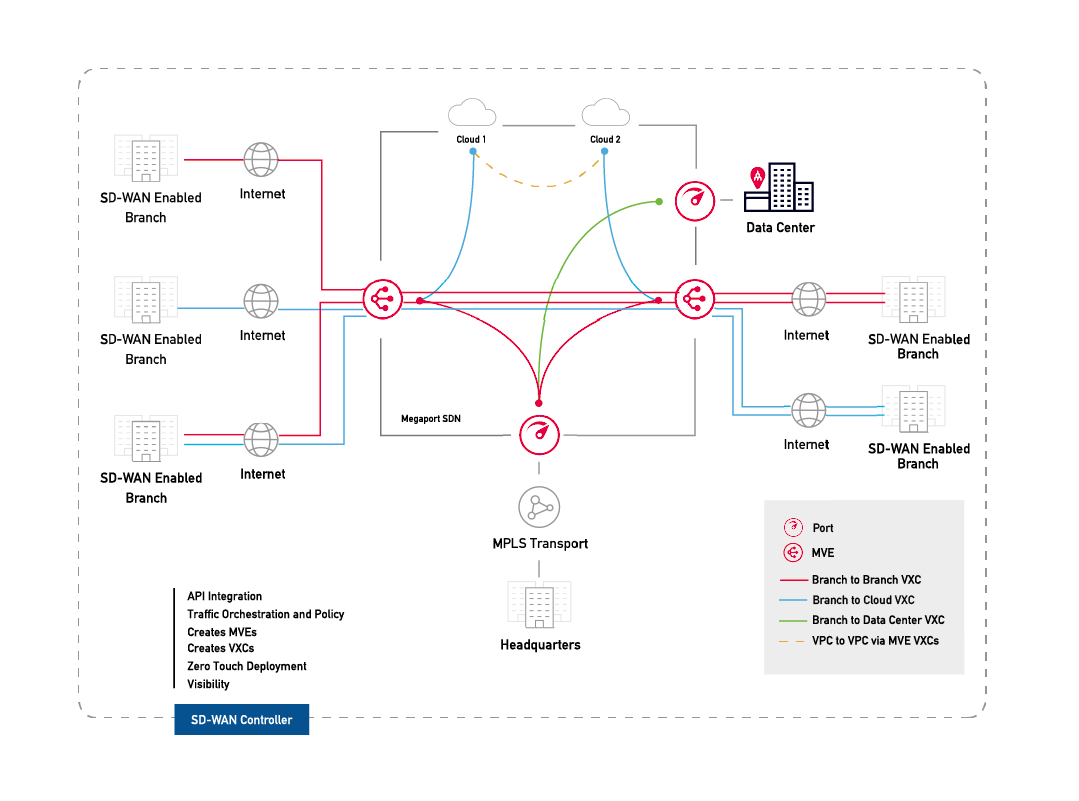
With two MVEs configured, you can create a private Virtual Cross Connect (VXC) to connect them on the Megaport network without the need for any physical infrastructure. A VXC is essentially a private point-to-point Ethernet connection between an A-End (MVE) and a B-End (another MVE).
Note
The internet-facing interface on an MVE can reach the internet-facing interface on another MVE over the public internet. That is, you can exchange traffic from MVE to MVE in different metros over the internet, within the same country. The basic connection model consists of an MVE at one metro connecting via a Megaport Internet connection to an MVE at another metro. Connectivity consists of a customer/SD-WAN partner-managed connection, not Megaport managed. For more information, see Megaport Internet Overview.
Before you begin
- Provision two MVEs in different locations. If you haven’t already created MVEs, see Creating an MVE Integrated with VMware.
Creating a VXC between two MVEs
Private VXC deployment between two VMware MVEs starts in the Megaport Portal where you will create the VXC. Then, you will configure the A-End and B-End MVE devices in the Orchestrator management console.
To create a VXC
-
In the Megaport Portal, go to the Services page and click +Connection next to the originating A-End MVE.
-
Select Private VXC and click Next.
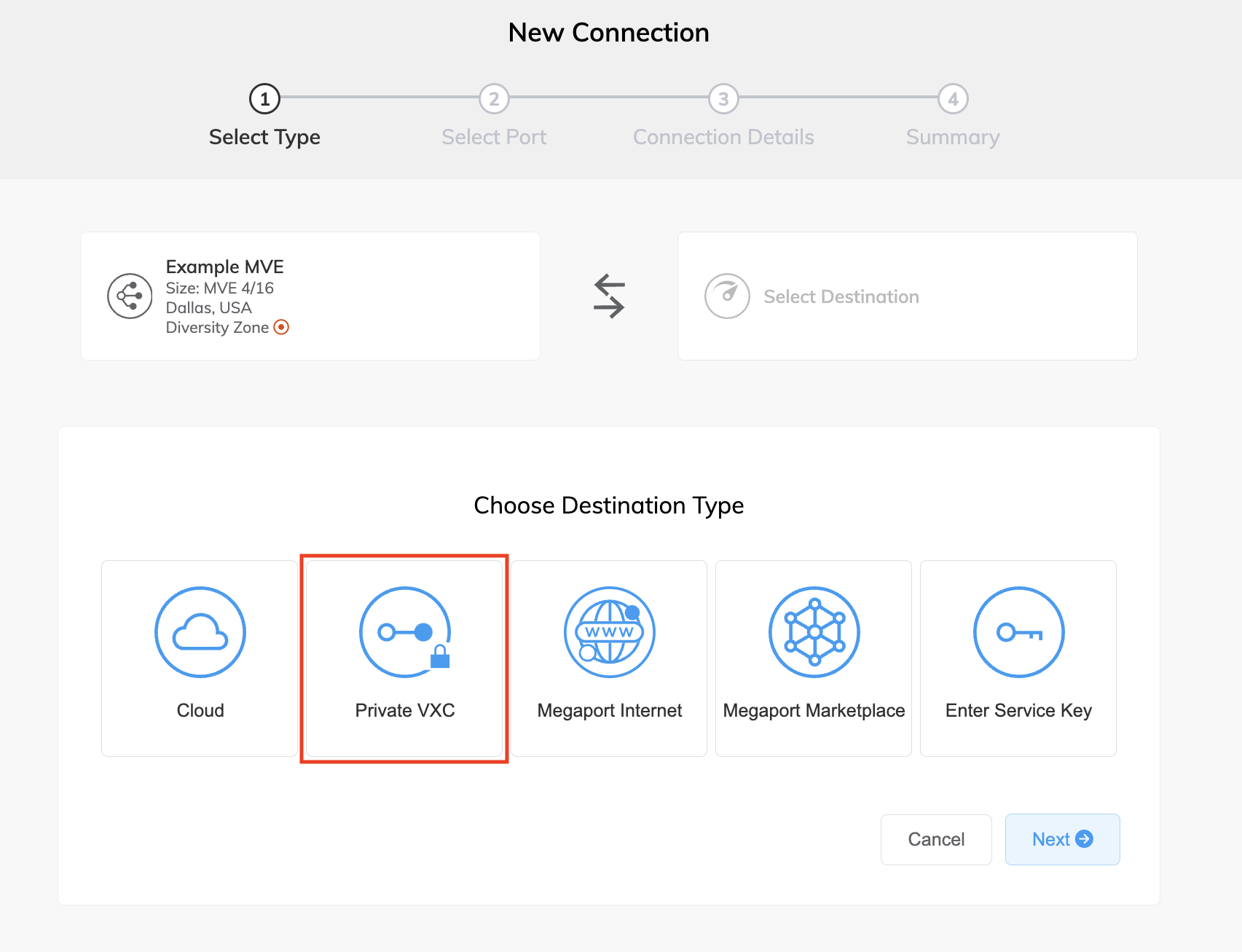
-
Select the destination B-End MVE and location.
Use the Country filter to narrow the selection. -
Click Next.
-
Specify the connection details:
-
Connection Name – The name of your VXC to be shown in the Megaport Portal. Specify a name for the VXC that is easily identifiable, for example, LA MVE 2 to Dallas MVE 4. You can change the name later, if you like.
-
Service Level Reference (optional) – Specify a unique identifying number for the VXC to be used for billing purposes, such as a cost center number or a unique customer ID. The service level reference number appears for each service under the Product section of the invoice. You can also edit this field for an existing service.
-
Rate Limit – The speed of your connection in Mbps. The maximum speed is displayed. Although the rate limit for a VXC can be up to 10 Gbps, the compute capacity of the A-End or B-End MVE can influence the circuit throughput. Consult VMware’s documentation for more information.
-
VXC State – Select Enabled or Shut Down to define the initial state of the connection. For more information, see Shutting Down a VXC for Failover Testing.
Note
If you select Shut Down, traffic will not flow through this service and it will behave as if it was down on the Megaport network. Billing for this service will remain active and you will still be charged for this connection.
-
vNIC selection – Depending on the definition of the MVEs you are using, you might have to specify A-End and B-End vNICs.
-
A-End vNIC – Specify a vNIC by using the pre-populated default, or select from the drop-down list.
-
B-End vNIC – Specify a vNIC by using the pre-populated default, or select from the drop-down list.
For more information on vNIC selection when connecting MVEs with different services, see Types of vNIC Connections.
-
-
Preferred A-End VLAN – Specify the 802.1q VLAN tag for this connection for the A-End.
Each VXC is delivered as a separate VLAN on the MVE. The VLAN ID must be unique on this MVE and can range from 2 to 4093. If you specify a VLAN ID that is already in use, the system displays the next available VLAN number. The VLAN ID must be unique to proceed with the order. If you don’t specify a value, Megaport will assign one. -
Preferred B-End VLAN – Specify the 802.1q VLAN tag for this connection that you will receive through the B-End VLAN.
-
Minimum Term – Select No Minimum Term, 12 Months, 24 Months, or 36 Months. Longer terms result in a lower monthly rate. 12 Months is selected by default.
Take note of the information on the screen to avoid early termination fees (ETF). See VXC Pricing and Contract Terms and VXC, Megaport Internet, and IX Billing for more information.
-
-
Click Next to view the Summary page.
-
Confirm the configuration and click Add VXC to save the VXC.
-
Click Order to proceed through the checkout process.
Once the VXC is deployed, you can view it in the Megaport Portal Services page. The Services page displays the VXC under the A-End MVE and the B-End MVE. Note that the service identifier number is the same for the VXC at both ends of the connection.
The next step is to configure the A-End and B-End MVEs in Orchestrator.
Note
The next procedure configures IP connectivity with BGP, providing just one solution out of many. Consult your SD-WAN vendor documentation for specific network design and configuration options before configuring interfaces for the MVEs.
Adding edge details to Orchestrator
After you create the VXC between your MVEs, you need to configure it in Orchestrator. This involves configuring IP addresses and VLAN tags for the interface.
To configure the A-End edge device
-
In Orchestrator, go to Configure > Edges.
-
Click the first edge device to configure (the A-End MVE device).
-
Select the Device tab and scroll down to the Interface Settings.
-
Click +Add Subinterface.
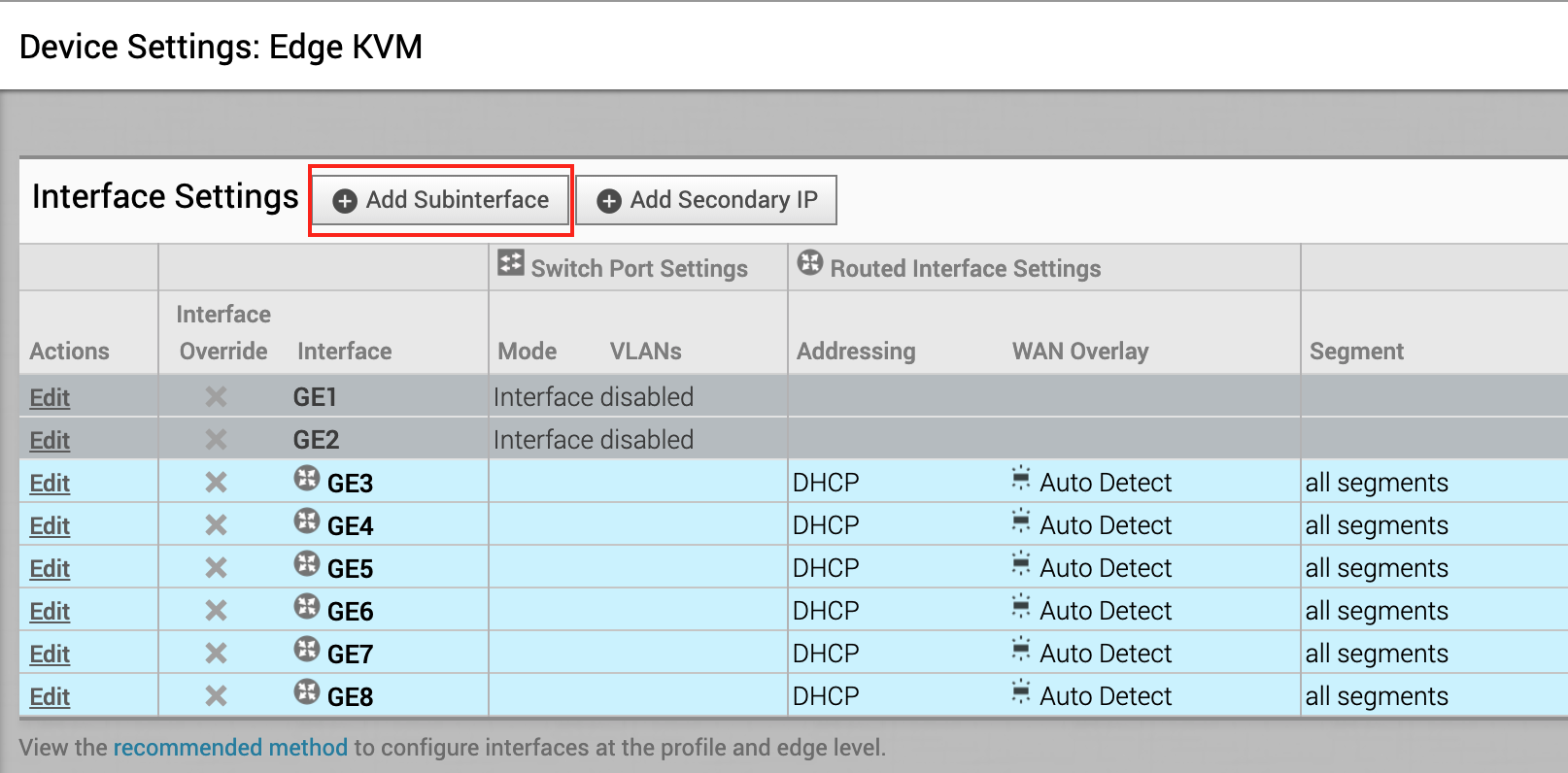
The Select Interface dialog box appears. -
From the Select Interface menu, choose GE3 and for the Subinterface ID enter the A-End VLAN ID configured on the MVE in the Megaport Portal.
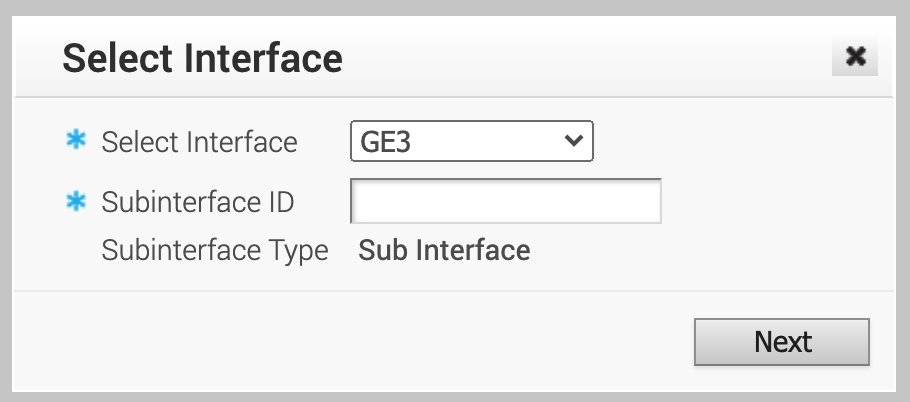
The subinterface settings appear. -
Click Next.
-
Ensure that Sub Interface Enabled is enabled.
-
Modify segments as needed for your SD-WAN configuration.
-
Change the Addressing Type to Static and provide the A-End IP Address, CIDR prefix, and Gateway.
-
Update other options as needed for your SD-WAN configuration.
-
Ensure Enable VLAN Tagging is enabled.
The VLAN field is automatically populated with the VLAN ID you specified for the subinterface ID.
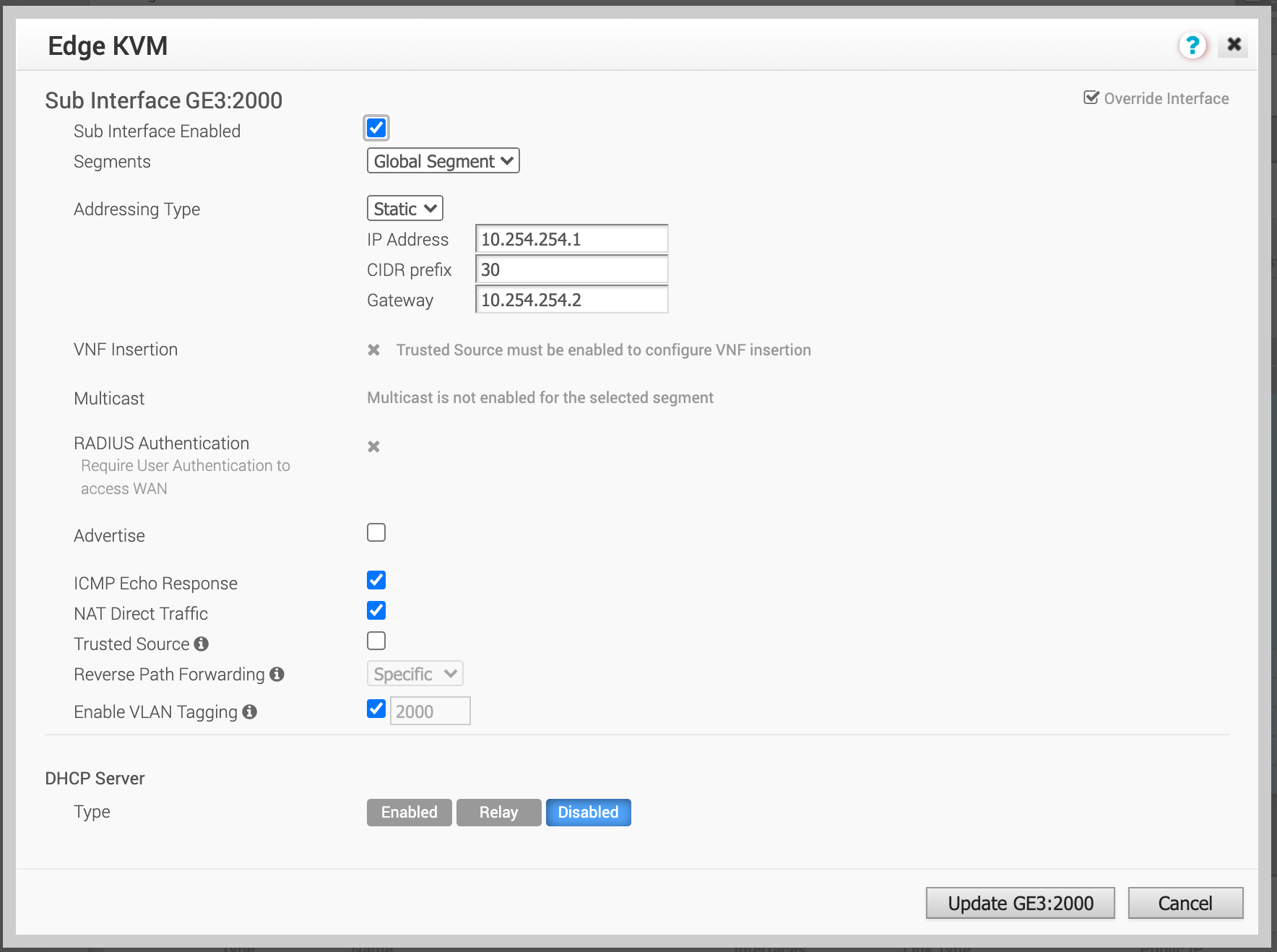
-
Click Update GE3:vlan-id.
-
In the upper-right corner of the Configure > Edges window, click Save Changes and then confirm.
This configures the interface, VLAN tags, and IP addresses so you can test with ping commands through the CLI. (BGP is not yet configured.)
Note
Adding the subinterface momentarily disrupts the connection.
To set up the MVEs to exchange routing information, follow the steps in To configure BGP in Orchestrator.
To configure the B-End edge device
-
In Orchestrator, go to Configure > Edges.
-
Click the second edge device to configure (the B-End MVE device).
-
Select the Device tab and scroll down to the Interface Settings.
-
Click +Add Subinterface.

The Select Interface dialog box appears. -
From the Select Interface menu, choose GE3 and for the Subinterface ID enter the A-End VLAN ID configured on the MVE in the Megaport Portal.

The subinterface settings appear. -
Click Next.
-
Ensure that Sub Interface Enabled is enabled.
-
Modify segments as needed for your SD-WAN configuration.
-
Change the Addressing Type to Static and provide the B-End IP Address, CIDR prefix, and Gateway.
-
Update other options as needed for your SD-WAN configuration.
-
Ensure Enable VLAN Tagging is enabled.
The VLAN field is automatically populated with the VLAN ID you specified for the subinterface ID.

-
Click Update GE3:vlan-id.
-
In the upper-right corner of the Configure > Edges window, click Save Changes and then confirm.
This configures the interface, VLAN tags, and IP addresses so you can test with ping commands through the CLI. (BGP is not yet configured.)
Note
Adding the subinterface momentarily disrupts the connection.
At this point, the interface is created. The next step is to optionally create the Border Gateway Protocol (BGP) session.
To configure BGP in Orchestrator (optional)
-
In Orchestrator, go to Configure > Edges and click the MVE device.
-
Click the Device tab and in the Configure Segments section click Enable Edge Override for BGP Settings.
This override lets you define BGP values specific for this device beyond the profile definition.

-
Click the toggle button to turn on BGP and click Edit.
The BGP Editor appears.

-
Enter the Local ASN for the A-End device.
Each device has its own unique ASN.
-
For the Neighbor IP, add the IP address from the B-End MVE device.
-
Add the B-End device ASN to the ASN field for the neighbor.
-
View all Additional Options and enable BGP options as needed.
For more information on BGP options in Orchestrator, see the VMware Documentation. -
Click OK and then click Save Changes.
Validating your connection
- In Orchestrator under Test & Troubleshoot > Remote Diagnostics, select the MVE and click Run for Troubleshoot BGP - Show BGP Summary to verify the BGP session and ensure the edge device is up.
You can also check connectivity and BGP status from the CLI of the edge device. For more information, see Reviewing your VMware MVE connection settings.